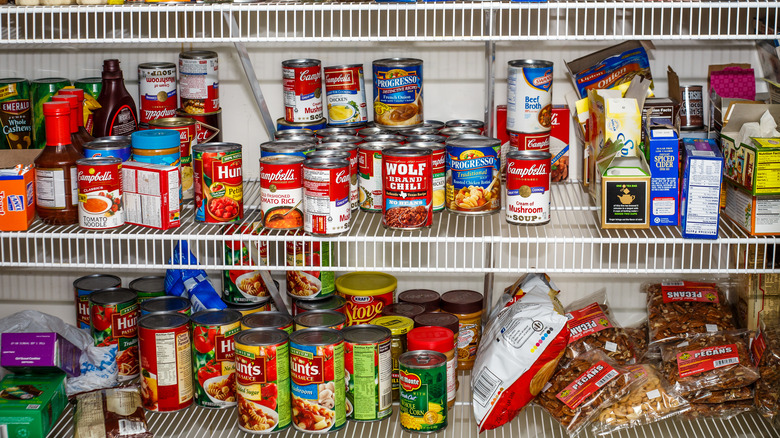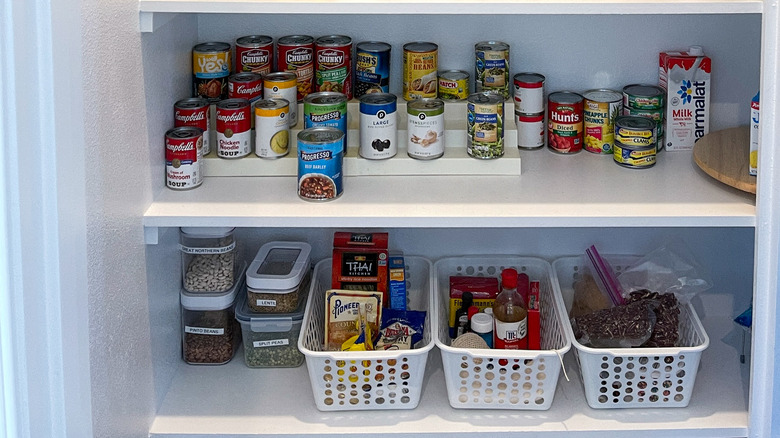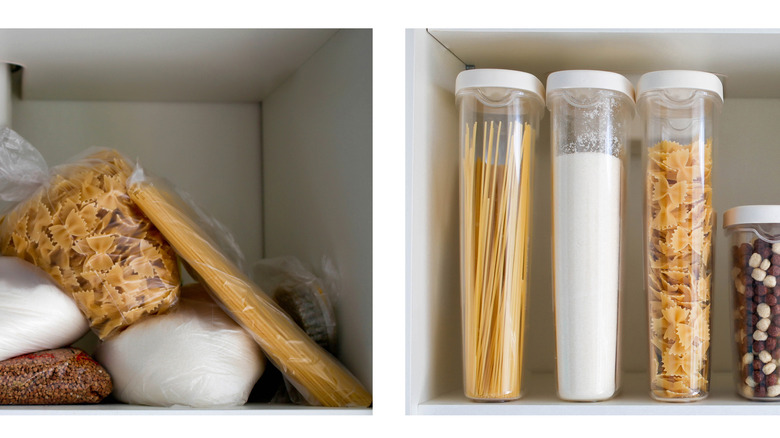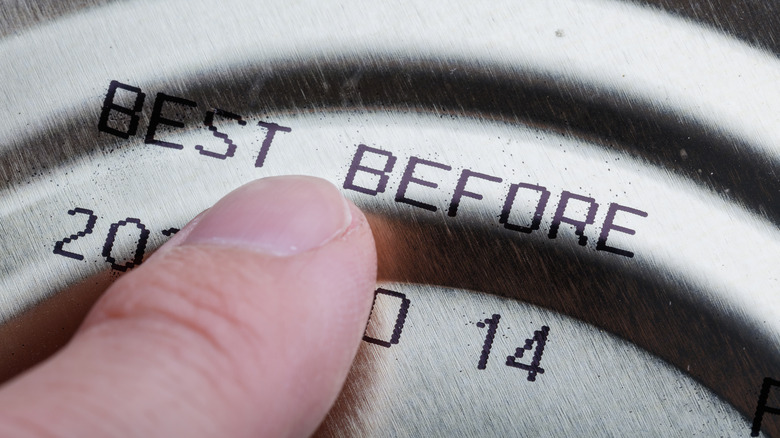Stop Making These 3 Space Wasting Mistakes In Your Pantry
Regardless of whether it's a walk-in closet, an added piece of furniture, or a few shelves within your kitchen cabinets, pantries are one of the trickiest spaces to get and keep organized. Making lunches, grabbing snacks, and preparing dinner every day means a lot of hands are in and out throughout a short period.
One of the last things you want to do is to make it more difficult to navigate than it needs to be. A cluttered pantry wastes time and money. It takes longer to find what you're looking for and put groceries away. It results in food expiring because it gets lost or you buy more than you need because you don't know what you have. Per the FDA, consumers who purchase surplus food help contribute to food waste which amounted to 133 billion pounds in 2010.
In contrast, making the most out of your pantry space will save you from these negative effects. Moreover, according to Motherly, having a tidy home to plan and cook your meals will likely result in healthier eating habits. And where does that prep start? In the pantry, of course! If you're ready to get yours better organized, check out these three space-wasting mistakes in your pantry and how to correct them.
Not maximizing the space to its capacity
Pantries come in all shapes and sizes; however, one of the most common issues is they're often awkwardly shaped — the shelves are deep, oddly spaced, or there are hard-to-reach corners. This certainly poses a problem, even for the most organized amongst us. Learning how to use the space within your pantry to its full potential will maximize it, so you're getting the most out of this precious real estate. There are a few hacks you can adopt to accomplish this.
One method to gain more storage, according to A Personal Organizer, is to make sure that you're using as much of the height of the shelves as possible. If they're adjustable, lower them for shorter items. If they're not, consider shelf risers or can organizers, which, as Abby Organizes says, provide effortless access on top of saving space. If you're struggling to reach the back of the pantry, consider installing sliding pull-out drawers as they eliminate the possibility of things disappearing out of sight.
Another tip to adopt is adding a lazy susan for hard-to-reach spots. There's a reason that they're often added inside of those awkward corner kitchen cabinets. Stick a few into the nooks of your pantry to use them more effortlessly, per Order to Everything. If you have extra height, aim for a two-tiered lazy susan to maximize it.
Keeping things in their original packaging
Another mistake is shoving stuff into the pantry in the same packaging they come home in. Now, this doesn't go for every item you bought at the grocery store, but there are quite a few staples that you should consider decanting. Spaghetti that comes in irregular-shaped boxes, bulk-sized bags of flour, and individually wrapped snacks are good examples of the best things to transfer into smaller, more space-saving jars or baskets within your pantry. Not only does matching food containers look pretty, but the streamlined shapes also take up considerably less room than the original packaging. In addition, they can often be stacked, once again taking advantage of vertical height.
According to food storage container brand, Oxo, following this method has a double benefit. It takes up less space and, since they're clear, lets you know exactly when you need to restock. It's a good idea to find air-tight containers that fit the amount that's within the bag or box itself. However, if you buy supersized products and are left with extra, Life in Jeneral suggests having an overstock section and refilling it when the container is low. This can result in fewer trips to the grocery store, less money spent, and less wasted pantry goods.
Failing to check expiration dates regularly
As mentioned, purchasing excess food only exacerbates the world's food waste problem. It also directly affects your bottom line. It's tempting to buy a large number of pantry goods, especially when it's a good deal. But if those boxes, bags, or cans are lost in the abyss of a messy pantry, it's a real possibility that the food will expire before you get a chance to use it. And while most non-perishable pantry goods are technically edible after their expiration, the USDA warns that the quality of taste will significantly diminish.
Keeping food past its prime is a waste of space in the pantry. But what's a simple way to make sure your items are always up to date? For one, maximizing the space, storing things visible within clearly marked storage containers, and keeping things accessible will make it easier for you to go through the pantry more often.
Try making it a habit by working it into your routine. If, for example, you shop for food every Sunday, spend just a few minutes before doing so scanning the pantry for expiring foods. This practice can allow you to plan to incorporate said foods into the next few meals, so they don't get wasted. If you don't think you need to check weekly, mark your calendar once a month or so as a gentle reminder.



